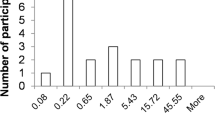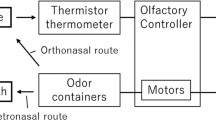Abstract
Enhancement of retronasal odors by sucrose has been shown to be a reliable perceptual phenomenon of taste–odor interactions. It is unknown, however, whether stimulus intensity modulates the degree of odor enhancement. The present study was therefore designed to investigate how the intensity of odor and taste alone affects the degree of odor enhancement. In the first experiment, subjects rated the intensities of taste and odor for aqueous solutions of sucrose and citral at three concentrations, both alone and in binary mixtures. The results showed that sucrose significantly increased the “citrus” ratings to an extent that was inversely related to the intensity of citral alone. Interestingly, the increase in sucrose intensity had insignificant effects on odor enhancement. To test the reliability of the relationship between odor intensity and the degree of enhancement, a second experiment was conducted in which subjects inhaled three concentrations of citral in vapor phase via the mouth while tasting sucrose. This procedure also provided an opportunity to rule out the possibility that the odor enhancement is the result of, at least in part, physicochemical interactions between sucrose and volatiles. Consistent with the previous results, the presence of sucrose in the mouth significantly enhanced the “citrus” ratings compared to when citral was inhaled alone, and the odor intensity relationship was preserved. These findings demonstrate that odor enhancement by sucrose is a perceptual phenomenon that occurs independent of physicochemical interactions between flavor components and that the degree of enhancement is greater when retronasal odors are weak.



Similar content being viewed by others
References
Baldwin RE, Korschgen BM (1979) Intensification of fruit-flavors by aspertame. J Food Sci 44:938–939
Bartoshuk LM, Duffy VB, Fast K, Green BG, Prutkin J, Snyder DJ (2002) Labeled scales (e.g., category, Likert, VAS) and invalid across-group comparisons: what we have learned from genetic variation in taste. Food Qual Prefer 14:125–138
Cardoso J, Bolini H (2008) Descriptive profile of peach nector sweetened with sucrose and different sweeteners. J Sens Stud 23:804–816
Clark CC, Lawless HT (1994) Limiting response alternatives in time-intensity scaling: an examination of the halo-dumping effect. Chem Senses 19:583–594
Davidson JM, Linforth RST, Hollowood TA, Taylor AJ (1999) Effect of sucrose on the perceived flavor intensity of chewing gum. J Agric Food Chem 47:4336–4340
Delarue J, Giampaoli P (2006) Carbohydrate–flavour interactions. In: Voilley A, Etievant P, (eds) Flavour in food. CRC, Boca Raton, pp. 208–228
Frank RA, Byram J (1988) Taste–smell interactions are tastant and odorant dependent. Chem Senses 13:445–455
Frank RA, Van der Klaauw NJ (1992) The influence of stimulus context and instructional set on odor-induced enhancement of taste. Chem Senses 17:625
Frank R, Wessel N, Shaffer G (1990) The enhancement of sweetness by strawberry odor is instruction-dependent. Chem Senses 15:576
Frank R, van der Klaauw N, Schifferstein H (1993) Both perceptual and conceptual factors influence taste–odor and taste–taste interactions. Percept Psychophys 54:343–354
Friel EN, Linforth RST, Taylor AJ (2000) An empirical model to predict the headspace concentration of volatile compounds above solutions containing sucrose. Food Chem 71:309–317
Green BG, Shaffer GS, Gilmore MM (1993) Derivation and evaluation of a semantic scale of oral sensation magnitude with apparent ratio properties. Chem Senses 18:683–702
Green BG, Dalton P, Cowart B, Shaffer G, Rankin K, Higgins J (1996) Evaluating the ‘labeled magnitude scale’ for measuring sensations of taste and smell. Chem Senses 21:323–334
Green BG, Nachtigal D, Hammond S, Lim J (2012) Enhancement of retronasal odors by taste. Chem Senses 37:77–86
Hollowood TA, Davidson JM, DeGroot L, Linforth RST, Taylor AJ (2002) Taste release and its effect on overall flavor perception. Chemistry of taste. American Chemical Society, Washington, pp 166–178
King BM, Duineveld CAA, Arents P, Meyners M, Schroff SI, Soekhai ST (2007) Retronasal odor dependence on tastants in profiling studies of beverages. Food Qual Prefer 18:286–295
Larson-Powers N, Pangborn R (1978) Descriptive analysis of sensory properties of beverages and gelatins containing sucrose and synthetic sweeteners. J Food Sci 43:47–51
Lim J, Johnson MB (2011) Potential mechanisms of retronasal odor referral to the mouth. Chem Senses 36:283–289
Lim J, Johnson MB (2012) The role of congruency in retronasal odor referral to the mouth. Chem Senses 37:515–522
Lindley MG, Beyts PK, Canales I, Borrego F (1993) Flavor modifying characteristics of the intense sweetener neohesperidin dihydrochalcone. J Food Sci 58:592–594
Murphy C, Cain W (1980) Taste and olfaction: independence vs interaction. Physiol Behav 24:601–605
Murphy C, Cain W, Bartoshuk L (1977) Mutual action of taste and olfaction. Sens Processes 1:204–211
Nahon DF, Navarroy Koren PA, Roozen JP, Posthumus MA (1998) Flavor release from mixtures of sodium cyclamate, sucrose, and an orange Aroma. J Agric Food Chem 46:4963–4968
Nawar WW (1971) Variables affecting composition of headspace aroma. J Agric Food Chem 19:1057–1059
Prescott J, Murphy S (2009) Inhibition of evaluative and perceptual odour–taste learning by attention to the stimulus elements. Q J Exp Psychol 62:2133–2140
Prescott J, Johnstone V, Francis J (2004) Odor–taste interactions: effects of attentional strategies during exposure. Chem Senses 29:331–340
Pfeiffer JC, Hort J, Hollowood TA, Taylor AJ (2006) Taste-aroma interactions in a ternary system: A model of fruitiness perception in sucrose/acid solutions. Percept Psychophys 68:216–227
Rabe S, Krings U, Berger RG (2003) Dynamic flavor release from sucrose solutions. J Agric Food Chem 51:5058–5066
Salles C (2006) Odour–taste interactions in flavour perception. Woodhead Publishing in food science, technology and nutrition. Woodhead, pp. 345–368
Schifferstein HNJ, Verlegh PWJ (1996) The role of congruency and pleasantness in odor-induced taste enhancement. Acta Psychologica 94:87–105
Stevenson RJ, Prescott J, Boakes RA (1999) Confusing tastes and smells: how odours can influence the perception of sweet and sour tastes. Chemical Senses 24:627–635
Taylor AJ (1998) Physical chemistry of flavour. Int J Food Sci Technol 33:53–62
Taylor AJ (2002) Release and transport of flavors in vivo: physicochemical, physiological, and perceptual considerations. Compr Rev Food Sci and Food Saf 1:45–57
Valdes R, Hinreiner E, Simone M (1956) Effect of sucrose and organic acids on apparent flavor intensity I. Aqueous solution. Food Technol 10:282–285
Veldhuizen MG, Shepard TG, Wang M-F, Marks LE (2010) Coactivation of gustatory and olfactory signals in flavor perception. Chem Senses 35:121–133
von Sydow E, Moskowitz H, Jacobs H, Meiselman H (1974) Odor–taste interactions in fruit juices. Lebensm Wiss Technol 7:18–24
Wiseman JJ, McDaniel MR (1991) Modification of fruit flavors by aspartame and sucrose. J Food Sci 56:1668–1670
Author information
Authors and Affiliations
Corresponding author
Rights and permissions
About this article
Cite this article
Fujimaru, T., Lim, J. Effects of Stimulus Intensity on Odor Enhancement by Taste. Chem. Percept. 6, 1–7 (2013). https://doi.org/10.1007/s12078-013-9140-5
Received:
Accepted:
Published:
Issue Date:
DOI: https://doi.org/10.1007/s12078-013-9140-5




